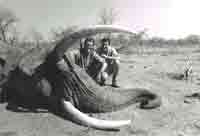In dubious battle
 An ecofascist's last stand at Harare
An ecofascist's last stand at Harare
India consistently voted for trade bans in products made from endangered species
the denouement was dramatic. The decision of the 10th Conference of Parties ( cop-10 ) on the Convention on International Trade in Endangered Species ( cites ) to allow restricted trade in ivory and limited culling of the African elephant in three African nations left the Indian delegation fuming. And confused. Led by a relatively junior official, the Additional Inspector-General of Forests (Wildlife) in the ministry of environment and forests ( mef ), S C Dey, the delegates had gone to Harare with a clear objective: oppose any proposal to lift the ban on trade in species. But the tremendous mobilisation of opinion by the African states at the venue caught the Indians off-guard.
"We were totally unprepared for that kind of pressure,' says Ashok Kumar of the Wildlife Protection Society of India ( wpsi ), who was a member of the delegation. That Ashok Kumar is one of India's leading anti-people wildlifers reflects the domination of India's wildlife establishment by ecofascist conservationists.
Adds a surprised S C Dey, "The media hype was tremendous. Every newspaper headline, every other programme on state-run television discussed the issue. Many delegates got thoroughly brainwashed.' The African nations, including the 31 African elephant range states, had had at least 10 meetings before the conference. They had reached a general consensus before the cites meet, although 10-odd countries in western and central Africa had reservations. While the Africans had done their homework, the Indian delegation did not even have figures to back their claim that Asian elephant populations would suffer from the downlisting.
Before the final voting, a working group chaired by Norway was set up to discuss possible control mechanisms for ivory trade. According to Dey, the delay in between the discussion and the voting "gave time to the host nation to try and convince countries abstaining from voting, or those opposed to the move, to get the required two-thirds majority.' The European Union ( eu ), which had initially opposed the proposal, compromised. But India, in a desperate last-minute bid, asked for another debate. The plea was rejected. Put to vote again, the proposal was passed, although the eu abstained.
Precarious situation
By voting against the downlisting, India found itself in an embarrassing political situation as well as isolated, since its stand was at total variance from most other developing countries'. So the delegates started playing their little games. "We were voting against countries with which we have had close political and economic relations,' says Dey. India did not speak out against the proposal independently. "We lobbied with the African countries which had reservations on the downlisting. During the discussions, we strongly supported these countries whenever they put up their points.'
An analysis of the Indian voting pattern at the Convention shows clearly that India opposed every proposal for downlisting, and supported all the proposals for increased protection of endangered species. So while India made a strong plea against South Africa's proposal to shift the African White Rhinoceros to Appendix ii , on the grounds that it would have negative repercussions on population of the Greater One-horned Rhinoceros in India.
Of the 77 proposals placed before cop -10, 30 were for downlisting of species from Appendix i to Appendix ii . Of these, 20 were accepted and 10 rejected. India voted against almost every proposal for downlisting, including the five on whales, put up by Japan and Norway; one for the Hawksbill Turtle, proposed by Cuba; and one on the Bengal Monitor and the Yellow Monitor lizards, initiated by Bangladesh. "Since Cuba is one of our supporters, we had to be diplomatic,' says Dey on the Indian stand on turtles. So, in an awkward attempt at diplomacy, the Indian delegation suggested that the issue be discussed under the Central Migratory Species Convention.
Predictably, India supported the listing of four birds
